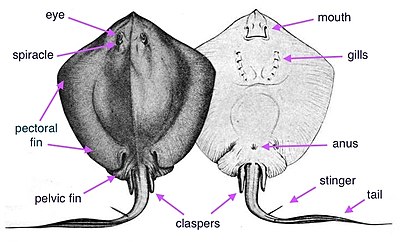
The short-tail stingray or smooth stingray is a common species of stingray in the family Dasyatidae. It occurs off southern Africa, typically offshore at a depth of 180–480 m (590–1,570 ft), and off southern Australia and New Zealand, from the intertidal zone to a depth of 156 m (512 ft). It is mostly bottom-dwelling in nature and can be found across a range of habitats from estuaries to reefs, but also frequently will swim into open water. One of the largest stingrays in the world, this heavy-bodied species can grow upwards of 2.1 m (6.9 ft) across and 350 kg (770 lb) in weight. Its plain-colored, diamond-shaped pectoral fin disc is characterized by a lack of dermal denticles even in adults, and white pores beside the head on either side. The body can have colors as well as dark grey or black with rows of white spots along each wing. Its tail is usually shorter than the disc and thick at the base. It is armed with large tubercles and a midline row of large thorns in front of the stinging spine which has the dorsal and ventral fin folds behind.

The longtail stingray, is a species of stingray in the family Dasyatidae, found in the eastern Pacific Ocean from Baja California to Colombia. It inhabits sandy habitats down to a depth of 90 m (300 ft). Measuring up to 1.56 m (5.1 ft) across, this species has a rhomboid pectoral fin disc, a lower fin fold on the tail, and numerous dermal denticles along the back and behind the stinging spine. The longtail stingray feeds mainly on bottom-dwelling bony fishes and crustaceans. It is aplacental viviparous, with females giving birth to 1–5 young in late summer. It is caught for food, likely throughout its range, but specific fishery data is lacking.

The Atlantic stingray is a species of stingray in the family Dasyatidae, common along the Atlantic coast of North America from Chesapeake Bay to Mexico, including brackish and freshwater habitats. It may be distinguished from other stingrays in the area by its relatively elongated snout. This species is of little commercial importance, other than for sale in the aquarium industry.

The southern stingray is a whiptail stingray found in tropical and subtropical waters of the Western Atlantic Ocean from New Jersey to southern Brazil. It has a flat, diamond-shaped disc, with a mud brown, olive, and grey dorsal surface and white underbelly. The barb on its tail is serrated and covered in a venomous mucus, used for self-defense.

The pelagic stingray is a species of stingray in the family Dasyatidae, and the sole member of its genus. It is characterized by the wedge-like shape of its pectoral fin disc, which is much wider than long, as well as by the pointed teeth in both sexes, whip-like tail with extremely long tail spine, and uniform violet to blue-green coloration. It generally reaches 59 cm (23 in) in width. The pelagic stingray has a worldwide distribution in waters warmer than 19 °C (66 °F), and migrates seasonally to spend the summer closer to the continental shelf and at higher latitudes. The only stingray that almost exclusively inhabits the open ocean, this species is typically found in surface waters down to a depth of 100 m (330 ft). As a consequence of its midwater habits, its swimming style has evolved to feature more of a flapping motion of the pectoral fins, as opposed to the disc margin undulations used by other, bottom-dwelling stingrays.
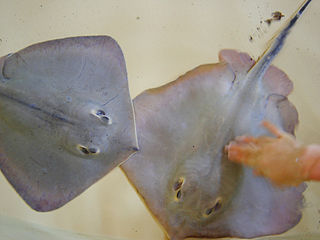
The red stingray is a species of stingray in the family Dasyatidae, found in the northwestern Pacific Ocean off Japan, Korea, and China, and possibly elsewhere. It primarily inhabits shallow, sandy habitats close to shore, and has been known to enter brackish water. The red stingray has a diamond-shaped pectoral fin disc and gains its common name from its bright orange-red underside; there may also be patches of orange at various spots on its upper surface. Most individuals are no more than 1 m (3.3 ft) long.

The diamond stingray is a species of stingray in the family Dasyatidae. It is found in the coastal waters of the eastern Pacific Ocean from southern California to northern Chile, and around the Galápagos and Hawaiian Islands. This bottom-dweller generally inhabits sandy or muddy flats near rocky reefs and kelp forests, to a depth of 30 m (98 ft), though off Hawaii it may range considerably deeper. As its common name suggests, this species has an angular, diamond-shaped pectoral fin disc that is plain brown or gray above, with rows of tubercles along the midline and on the "shoulders". The long, whip-like tail has both dorsal and ventral fin folds, which distinguish this ray from the closely similar longtail stingray. It typically grows to 1 m (3.3 ft) across.
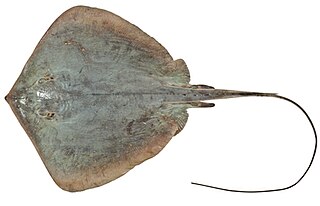
The estuary stingray, also called the estuary stingaree or brown stingray, is a species of stingray in the family Dasyatidae. Endemic to eastern Australia, it typically inhabits shallow, mangrove-lined tidal rivers, estuaries, and bays in southern Queensland and New South Wales. This yellow-brown to olive ray grows to at least 93 cm (37 in) across. It has a diamond-shaped pectoral fin disc and a mostly smooth, whip-like tail bearing both dorsal and ventral fin folds. It can additionally be identified by its long, narrow nostrils and the row of thorns along the midline of its back.
The Niger stingray or smooth freshwater stingray is a species of stingray in the family Dasyatidae, native to rivers in Nigeria and Cameroon. Attaining a width of 40 cm (16 in), this species can be distinguished by its thin, almost circular pectoral fin disk, slightly projecting snout tip, and mostly smooth skin with small or absent dermal denticles. The Niger stingray feeds on aquatic insect larvae and is ovoviviparous. The long stinging spine on the tail of this ray can inflict a painful wound. It has been assessed as Critically Endangered by the International Union for Conservation of Nature (IUCN), as its numbers are declining in some areas and it faces heavy fishing pressure and habitat degradation.

The sharpsnout stingray or wingfin stingray is a species of stingray in the family Dasyatidae, found from off Venezuela to northern Brazil. It inhabits shallow, brackish water, shifting towards the coast in the dry season and away from it in the rainy season. Typically measuring 70 cm (28 in) across, this dark brown ray is easily identifiable by its long, projecting snout and elongated, acutely pointed pelvic fins. Its diet consists of bottom-dwelling invertebrates. Reproduction is aplacental viviparous, with females bearing one to three pups annually. Naturally uncommon and slow-reproducing, the sharpnose stingray is under pressure by both artisanal and commercial fisheries, leading the International Union for Conservation of Nature (IUCN) to assess it as critically endangered.

The longnose stingray is a species of stingray in the family Dasyatidae, native to the western Atlantic Ocean from the southern Gulf of Mexico to Brazil. Found in coastal waters no deeper than 36 m (118 ft), this demersal species favors muddy or sandy habitats. The longnose stingray is characterized by its angular, rhomboid pectoral fin disc, moderately projecting snout, and whip-like tail with a dorsal keel and ventral fin fold. It typically grows to 1.25 m (4.1 ft) across and is brownish above and light-colored below.

The Mekong freshwater stingray, Hemitrygon laosensis, is a species of stingray in the family Dasyatidae, restricted to the Mekong and Chao Phraya Rivers in Laos and Thailand; the occurrence in Chao Phraya is considered an introduction. Measuring up to 62 cm (24 in) across, this ray has an oval pectoral fin disc, a tail with both upper and lower fin folds, and a midline row of spine-like dermal denticles. A characteristic feature of this species is its bright orange underside. The Mekong freshwater stingray preys on invertebrates and is aplacental viviparous. It has been assessed as Endangered by the International Union for Conservation of Nature (IUCN), as it is threatened by overfishing and habitat degradation.
The Brazilian large-eyed stingray, Hypanus marianae, is a species of stingray in the family Dasyatidae. Endemic to northeastern Brazil, adults of this species inhabit shallow coral and sandstone reefs while the young are also found near beaches and in estuaries. This stingray measures up to 40 cm (16 in) across and can be identified by its large eyes, equally long fin folds above and below the tail, and distinctive coloration consisting of various dark brown markings on a yellowish-brown background above, and two pairs of dark brown blotches on a white background below. Reproduction is aplacental viviparous, with females giving birth to one young at a time, twice a year, and using sandbanks as nursery areas. The Brazilian large-eyed stingray is collected by artisanal fisheries and for the ornamental fish trade.

The pale-edged stingray or sharpnose stingray is a species of stingray in the family Dasyatidae, found in the Indian and Pacific Oceans from India to the western Malay Archipelago and southern Japan. This bottom-dwelling ray is most commonly found over sandy areas shallower than 100 m (330 ft), as well as in estuaries. Measuring up to 29 cm (11 in) across, the pale-edged stingray has a diamond-shaped pectoral fin disc, a long projecting snout, small eyes, and a whip-like tail with both dorsal and ventral fin folds. It is chocolate brown above and white below.
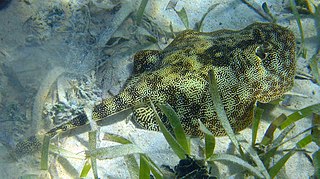
The yellow stingray is a species of stingray in the family Urotrygonidae, found in the tropical western Atlantic Ocean from North Carolina to Trinidad. This bottom-dwelling species inhabits sandy, muddy, or seagrass bottoms in shallow inshore waters, commonly near coral reefs.
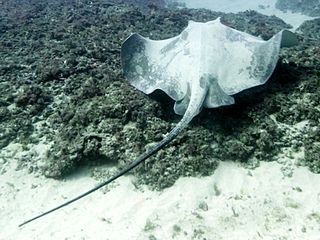
The broad stingray, also known as the brown stingray or Hawaiian stingray, is a species of stingray in the family Dasyatidae. They range across the Indo-Pacific from southern Africa to Hawaii, and are the predominant species of stingray in the inshore waters of the Hawaiian Islands. This benthic fish also inhabits sandy or muddy flats at depths greater than 15 m (49 ft) in the Eastern Atlantic, from southern France to Angola, including the Mediterranean Sea. Usually growing to 1 m (3 ft) across, the broad stingray has a wide, diamond-shaped pectoral fin disc with a protruding snout tip and a long tail with a ventral fin fold. At night, this species actively forages for bottom-dwelling invertebrates and bony fishes, often near the boundaries of reefs. Reproduction is aplacental viviparous. As substantial threats to its population exist in many areas of its wide distribution, IUCN has listed this species as Vulnerable.

The common stingray is a species of stingray in the family Dasyatidae, found in the northeastern Atlantic Ocean and the Mediterranean and Black Seas. It typically inhabits sandy or muddy habitats in coastal waters shallower than 60 m (200 ft), often burying itself in sediment. Usually measuring 45 cm (18 in) across, the common stingray has a diamond-shaped pectoral fin disc slightly wider than long, and a whip-like tail with upper and lower fin folds. It can be identified by its plain coloration and mostly smooth skin, except for a row of tubercles along the midline of the back in the largest individuals.

The roughtail stingray is a species of stingray in the family Dasyatidae, with separate populations in coastal waters of the northwestern and southwestern Atlantic Ocean. This bottom-dwelling species typically inhabits sandy or muddy areas with patches of invertebrate cover, at a depth of 15–50 m (49–164 ft). It is seasonally migratory, overwintering in offshore waters and moving into coastal habitats for summer. The largest whip-tail stingray in the Atlantic, the roughtail stingray grows up to 2.6 m (8.5 ft) across and 360 kg (800 lb) in weight. It is plain in color, with an angular, diamond-shaped pectoral fin disc and a long, whip-like tail bearing a subtle fin fold underneath. The many thorns on its back and tail serve to distinguish it from other stingrays that share its range.

The smalleye stingray is a large species of stingray in the family Dasyatidae, measuring up to 2.2 m (7.2 ft) across. Rare but widely distributed, it is found in the Indo-Pacific from Mozambique to India to northern Australia. This species may be semi-pelagic in nature, inhabiting both deeper waters and shallow coastal reefs and estuaries. It is characterized by a diamond-shaped pectoral fin disc much wider than long, a tail that is broad and flattened in front of the spine but whip-like behind, and large white spots over its back.

The pearl stingray is a little-known species of stingray in the family Dasyatidae, found in shallow coastal waters from Mauritania to Angola, though fossils have been found in Portugal. Growing to 30 cm (12 in) across, this species has a rounded pectoral fin disc with a pointed snout, and a wide band of dermal denticles over the back in adults. It closely resembles and is often confused for the much larger daisy stingray ; both species are characterized by the presence of an enlarged, nacreous denticle in the middle of the back called a "pearl spine". The International Union for Conservation of Nature (IUCN) assesses the pearl stingray's conservation status as Near Threatened, but it is likely that most of the historically reported fishery catches of the daisy stingray were in fact of this species.


